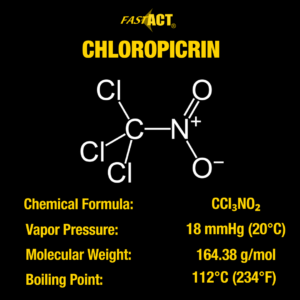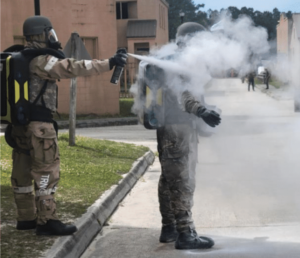Chloropicrin: Understanding the Threat and How to Respond Safely with FAST-ACT Dry Decontamination
What Is Chloropicrin?
According to the CDC, Chloropicrin (CCl₃NO₂) is a volatile, oily liquid with a sharp, irritating odor. First synthesized in the 19th century, it was used as a chemical warfare agent during World War I and later repurposed as a soil fumigant in agriculture. Classified as both a choking agent and a potential riot control agent, chloropicrin causes immediate irritation to the respiratory tract, eyes, and skin.
Its boiling point is approximately 112°C (234°F), and it has a relatively high vapor pressure, making it especially hazardous in enclosed or poorly ventilated areas. These properties allow it to disperse quickly into the air and affect large groups of people—posing serious challenges for emergency response teams.

Why Is It Relevant Now?
While its use in agriculture is tightly regulated, chloropicrin’s role as a banned warfare agent has come back into focus. According to a Reuters report, Russian forces have reportedly deployed chemical weapons in Ukraine, including chloropicrin. The Dutch Defense Minister stated that such use is widespread, despite being a clear violation of international law.
This re-emergence has reignited concerns among hazmat teams and defense agencies about preparedness for chemical agents that affect the respiratory system and can cause lasting damage after even brief exposure.
Why Is Chloropicrin Banned?
Chloropicrin is banned under the 1997 Chemical Weapons Convention, which is enforced by the Organisation for the Prohibition of Chemical Weapons (OPCW). The OPCW classifies it as a choking agent, alongside more well-known substances like sulfur mustard.
The agent’s effects on the respiratory tract, including coughing, difficulty breathing, and chemical-induced inflammation, make it a significant health risk. Its ability to incapacitate rather than immediately kill is part of what led to its designation as a chemical warfare agent and its prohibition under international law.
Chloropicrin Toxicity and Exposure Risks
Chloropicrin toxicity depends on concentration and duration of exposure. It has been studied using methods such as gas chromatography to evaluate exposure levels in air and biological samples.
Health effects include:
- Severe irritation to the respiratory tract, eyes, and skin
- Persistent coughing and choking
- Headaches, dizziness, and nausea
- Occupational exposure risks in industries where it’s still used as a fumigant
- In extreme cases, pulmonary edema or long-term respiratory damage
Response Challenges and Decontamination Needs
Chloropicrin’s physical properties make it uniquely difficult to manage:
- Its high vapor pressure allows it to volatilize and spread rapidly
- It acts primarily through inhalation, targeting the respiratory system
- Standard wash-down decontamination may be ineffective or hazardous
- In field situations, water is not always available or advisable for decon procedures
Because of these challenges, response teams must rely on fast, effective dry decontamination tools that can neutralize vapors and prevent spread without creating runoff or secondary hazards.
Preparing for Chemical Threats in the Field with FAST-ACT
FAST-ACT provides a field-ready response platform for neutralizing a broad spectrum of chemical agents, including vapor-phase threats like chloropicrin. In chemical emergencies, especially where agents impact the respiratory system, responders need tools that:
- Can be deployed quickly without specialized equipment
- Are safe for use on skin, gear, and in confined spaces
- Address occupational exposure and mass-casualty scenarios
- Work effectively and neutralizes against substances like chloropicrin, sulfur mustard, and other unknown chemical warfare agents
Here’s how FAST-ACT solutions can be used in real-world response scenarios:
-
FAST-ACT Pressurized Cylinders
Designed for immediate deployment in enclosed or contaminated areas, these cylinders disperse a dry powder that rapidly adsorbs and neutralizes airborne chemicals. In a scenario where chloropicrin vapors are present in a structure or confined space, first responders can activate the cylinder to reduce airborne concentrations and create safer conditions for entry or evacuation. -
FAST-ACT Decon Mitts
These CE-certified mitts are safe for direct use on skin and ideal for spot-cleaning both people and equipment. For example, if a responder’s gloves or uniform are exposed to a fine mist or residue of chloropicrin, the mitts offer a fast and effective way to wipe down and neutralize the chemical without requiring a full wash-down or water source. -
FAST-ACT Decon Wipes
Also CE-certified for use on skin, these wipes are designed for personal and equipment-level decontamination. During field triage or equipment handling, responders can safely use these wipes to clean exposed skin, masks, tools, or other gear suspected of chemical contact.

By integrating vapor-neutralizing tools into response plans, agencies can significantly reduce health risks to personnel and civilians alike.
Final Thoughts
Chloropicrin’s reappearance in modern conflict serves as a reminder that historical chemical warfare agents continue to pose real threats today. Understanding its properties—like boiling point, vapor pressure, toxicity, and how to decontaminate—is key for effective risk assessment and emergency response.
With renewed focus on chemical preparedness, now is the time for agencies to revisit their decontamination protocols and ensure they are equipped to handle banned substances like chloropicrin safely and effectively.
For more information, feel free to contact our team.

About Timilon Corporation:
Timilon Corporation is the manufacturer of FAST-ACT®, a proprietary formulation of non-toxic high-performance specialty materials effective at neutralizing a wide range of toxic chemicals with the added capability to destroy chemical warfare agents. The FAST-ACT technology is utilized by leading defense agencies, chemical industrial companies, first responders and HAZMAT teams to quickly and safely eliminate chemical hazards. For more information, reach out to Leticia Menzzano, Marketing Manager, lmenzzano@timilon.com.

